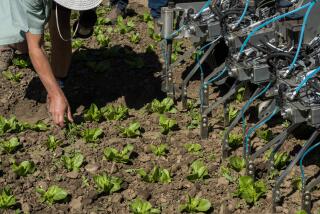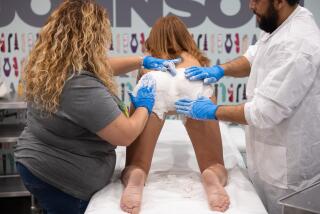From PC to Factory : Computer-Aided Processes May Revolutionize Industrial Design
- Share via
Sitting at their computers, office workers have long been able to push the “print” button and watch the screen’s two-dimensional contents scroll out on paper. That seemingly simple act is now being applied to three-dimensional parts--and the impact on industries ranging from toys to toolmaking promises to be enormous.
Call these new processes desktop manufacturing or rapid prototyping or three-dimensional printing. They dispense with complex engineering processes and time-consuming model building, enabling designers to create objects directly from computers.
Proponents, including several small Southland companies that are leaders in this fledgling industry, are promising a revolution.
“I compare this technology to what the computer did to our world in the last 20 years,” says Aroob Zutshi, research manager at Frost & Sullivan in Mountain View, Calif., who has followed desktop manufacturing for the past four years. “The depth and range of applications is incredible.”
He sees it eventually becoming “another peripheral in your home. You break a doorknob, you design your own and manufacture it.”
The industry has quite a ways to go before reaching that promised land. For one thing, there are patent disputes and technical problems still to be resolved. For another, prices for the computer-aided workstations and exotic manufacturing machinery are well into the six figures, meaning they won’t be used for home repair anytime soon.
But more than a few leading manufacturers are already taking the plunge. When Mattel Inc. set out to revamp its venerable line of Hot Wheels cars last fall--aiming to replace the realism of metal die-cast cars with futuristic designs in plastic--time was short. The company had just five months to prepare for the New York Toy Fair in February, and it normally takes 18 months to create a new toy line.
To meet the deadline, the company dispensed with model building and traditional development methods, relying instead on a $500,000 desktop manufacturing machine from 3-D Systems of Valencia. Company designers were able to produce in two days prototypes that used to take two weeks to assemble manually. The deadline was met--and Mattel was sold on the process.
Mattel expects the system to save it $1.8 million over five years. And cost isn’t the only benefit: “We get better end products and a faster reaction time to market change,” said Dave Carman, director of product engineering at Mattel. “And the prototype also represents more accurately the artist’s concept.”
While the exact processes and capabilities of the desktop manufacturing systems now on the market vary widely, all are based on essentially the same principles. A designer creates a product or part on a powerful computer workstation using computer-aided design software. The workstation prints the information to a mechanism that translates the CAD files into solid 3-D objects--generally by building the object layer by layer.
3-D Systems’ technology, a form of stereolithography, is based on the principle that certain liquid plastics will solidify when exposed to ultraviolet light. A CAD workstation sits beside a vat filled with the special plastics, known as photopolymers. The software “slices” the design mathematically into thin cross-sections. An ultraviolet laser then passes over the vat’s surface, tracing the form of each slice.
The liquid solidifies wherever the UV beam strikes, creating a solid copy of the computer cross-section. Each successive slice is built the same way until a solid whole is created. The Swiss chemical company Ciba-Geigy owns 35% of 3-D Systems, and the two firms are doing joint research and development on polymers.
Another Southland company, Soligen Technologies, may have pushed the technology even further. The Northridge-based firm has designed a computer-driven machine that can create a ceramic mold, which, when baked, is ready to accept molten metal for product casting. Its Direct Shell Production Casting is based on Three Dimensional Printing, a technology developed at the Massachusetts Institute of Technology and licensed by Soligen.
As with other processes, Direct Shell Production Casting slices a computer design into cross-sections. An ink-jet print head passes over a bin of alumina ceramic powder, but instead of ink it ejects tiny drops of glue onto a layer of the powder. The resulting shape matches the layer’s cross-section. Layer by layer, the alumina powder hardens into a solid ceramic mold.
Soligen has sold machines to aircraft engine maker Pratt & Whitney, the orthopedic division of Johnson & Johnson, and Ashland Chemical. Ashland approached Soligen after reading about its process and is helping to develop the glues, or binders.
“A number of our customers are interested,” said Mike Schwartzlander, director of marketing and technical services in the foundry products division of Ashland. His customer list includes virtually all the developed world’s automotive companies, already heavy users of 3-D Systems’ process. Soligen recently completed the purchase of a foundry in Santa Ana to produce metal parts from the ceramic molds.
3-D Systems’ binary magic can be found in the offices of all manner of manufacturers, from Boeing, Lockheed, McDonnell Douglas and Hughes in the aerospace sector to the Big Three auto makers to computer manufacturers IBM, DEC and Apple. Independent service bureaus fill the gap for companies wanting a quick turnaround without the minimum capital investment of $100,000.
“I have a lot of clients I have never met,” said Scott Turner, owner of Scicon Technologies Corp. in Valencia, a service bureau. “They send their data over the phone lines. FedEx delivers the model.”
Turner has also worked closely with Dr. Nicholas Mankovich at Los Angeles County Olive View/UCLA Medical Center to produce more accurate models of skulls for reconstructive work in UCLA’s maxillofacial clinic. The result allows surgeons to prepare implants with a better fit, reducing the time spent in the operating room making adjustments.
Yehoram Uziel, co-founder and chief executive of Soligen, envisions a day when surgeons will order custom implants for hip replacements, for example. “Not only will you save hours of surgery, but you get a better fit,” he said.
Just how popular will this technology become, and how quickly? Zutshi of Frost & Sullivan said the industry will have revenue of $750 million to $800 million by 1998. As an indicator of the potential dollars at stake, patent lawsuits have already broken out. Soligen faces a patent infringement suit from Austin-based DMT Corp. DMT filed papers last month in U.S. District Court for the District of Delaware. 3-D Systems and Quadrax Technologies Inc. went head to head in 1992.
Desktop Manufacturing
Using technology licensed from MIT, Soligen Inc. has created a “three-dimensional printing” system that can construct objects directly from computerized design information. The process will be used to create casting molds, which in turn will be used to produce metal parts for industry.
Step 1: A part is designed on a computer, using computer-aided design (CAD) software.
Step 2: Soligen’ software designs a casting mold of the part, and then “slices” the design into layers.
Step 3: The machinery deposits a thin layer of powder for the first slice of the casting mold.
Step 4: An ink-jet print head, similar to that used in a compute printer, deposits binder, a material which solidifies the powder into ceramic.
Step 5: The process is repeated until until all layers of the mold have been formed.
Step 6: Loose powder is removed from the completed mold, which is then fired in a kiln.
Step 7: Molten metal is poured into the mold to create the finished product.
Soligen’s Direct Shell Production Casting Machine
Print head sprays binder on each layer.
Rollers compress each layer before binding.
Powder hopper
Powder distributor
Powder
Bin holds mold.
Sources: Soligen Technologies






